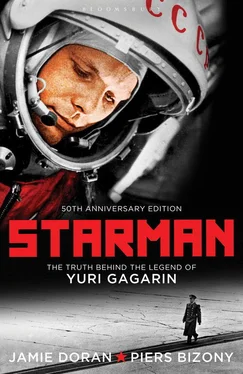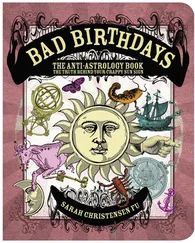Embarrassing and exhausting. Ivanovsky and his colleagues had worked non-stop on Vostok’s pre-launch checks, ever since the rocket had reached the pad on the morning of April 11. They had checked the life-support system, the propulsion systems, the navigation gyros: the awesome combinations of electrical energy and explosive chemicals that could miscombine in some small way at any moment and blow Gagarin into pieces (and possibly topple the rocket on its pad, spilling death and destruction across half of Baikonur). They had checked and re-checked, and now this failure of a couple of simple switches on the hatch threatened to ruin everything in the very last minutes before launch. As they pulled off the hatch, Ivanovsky hardly dared look into the cabin. What might Yuri be thinking? ‘In fact it was impossible to see his face at that moment. You could only see the top of his white space helmet. Sewn into the fabric of the left sleeve of the spacesuit there was a little mirror, which enabled the cosmonaut to look up at the hatch area, or other areas [of the upper cabin] normally blocked from view [by the rim of his bulky helmet]. He tilted his sleeve so that I could catch a glimpse of his face in the mirror. He was smiling and everything was fine.’ Gagarin was whistling quietly to himself as Ivanovsky and his colleagues replaced the hatch.
Those thirty bolts again. Tightening the opposite pairs, and Korolev’s voice on the phone, more forgiving now: ‘KP-3 is in order.’ Ivanovsky does not want to apportion blame, but as far as he can remember, the hatch had looked perfectly good to him right from the start, and he decided that someone in the blockhouse must have made an error reading the data. He would not have minded, except that the KP-3 business gave him a very nasty moment. Now it was the 40-minute mark, and the people in the blockhouse had sent the signal exactly on time to make a partial retraction of the gantries and walkways around the rocket. The platform that Ivanovsky and his four companions were standing on started to move away from Vostok. Any second now it would rotate down to forty-five degrees and they would fall off. There was an awkward moment when they had to use the gantry telephone to request a brief delay in the retraction. They quickly patted Vostok’s ball for luck, then climbed down from the gantry as fast as they could. Their feet were barely on the ground when the hydraulic motors started up again to pull the platforms away.
Ivanovsky headed for the nearest control bunker, while cameraman Vladimir Suvorov opted to stay out in the open, anxious not to miss the most important photographic opportunity of his life. He and his assistants prepared various cameras – manual and automatic – around the pad, only to find themselves being manhandled by soldiers with strict orders to clear the entire area prior to launch. The officer in charge was furious that Suvorov could be so stupid as to stay outside. ‘No film crews are allowed. I’m in charge here, and I’m ordering you into the shelters now!’ The cameraman’s righteous rage turned out to be the stronger. ‘We’re on official assignment! Here, I’ll write you a note,’ he sneered. ‘I am staying outside by my own wishes. In case of my death you are not responsible, all right?’
‘Okay, okay. No hard feelings.’ The guards retreated and Suvorov got his historic shots. [13] Suvorov & Sabelnikov, The First Manned Spaceflight , pp. 64–5.
The crew bus pulled back from the pad, and Titov was escorted to an observation bunker so that he could strip off his suit. Gai Severin’s technicians came at him again like predators, stripping off his gloves, his air hoses and restraint harness, taking him to pieces. He was all flapping arms and crumpled legs, a tangle of stiff fabric, with the neckpiece halfway over his head, when the technicians suddenly rushed away towards the bunker’s exit. The launch had started, and they wanted to go outside to see it. ‘They forgot about me,’ Titov recalls mournfully. ‘I was all alone.’ He waddled to the exit behind everybody else, clumped up the stairs and emerged onto the observation platform on the bunker’s roof.
To this day Titov vividly remembers everything he saw and felt in the next few moments. ‘I could hear the high-pitched wine of the fuel pumps pushing fuel into the combustion chambers, like a very loud whistle. When the engines fire up, there’s a whole spectrum of sound frequencies, from high-pitched screams to low rumblings.’ He knew the R-7 was hanging over the gulch of the flame trench, suspended on the gantry’s four slender support arms. The engines were going through their paces for a few seconds, adjusting to their unimaginable stresses in the last moments before the deliberate inferno of main thrust. ‘I saw the base of the rocket belching fire when the engines were igniting, and there were stones and pebbles [from the surrounding scrubland] flying through the air because of the blast.’ He watched the claw-like hold-down clamps around the rocket falling away; heard later, much later, the noise too loud to be heard, as the belated soundwave arrived. ‘It hammers your ribcage, shaking the breath out of you. You can feel the solid concrete bunker shaking with the noise… The light of the rocket’s exhaust is very bright… I saw the rocket rise and sway from side to side slightly, and I knew from this that the secondary steering nozzles were doing their job properly… It’s no good describing a rocket launch. Every one is different, and I’ve seen many. To describe a rocket launch in words is a hopeless task. You have to see it. Every time, it’s as if for the first time.’
Titov watched the brilliant fire climb high and dwindle to a spark, a fading impression on the retina, until all that was left was a pungent smoke trail and a silence suddenly much more deafening than the original blast, and all the other people on the platform with their backs turned against him.
Then, back down in the bunker, Gagarin coming through on the radio link, reporting from space. ‘It was strange to hear Yuri’s voice… We were sitting together here just half an hour ago, and now he was up there somewhere. It was hard to understand. Time somehow lost its dimensions for me. That’s how I felt.’
Titov on the ground, forgotten. Gagarin up there: the first man in space, his name surviving for as long as human memory survives. And Titov a white-haired businessman and Duma politician in Moscow today, turning up sometimes at Baikonur to watch the paintwork crumble on an old summerhouse, where they took his day away from him.
And if any cosmonaut was more disappointed than Titov, it must have been Grigory Nelyubov, who came within a whisker of making the flight himself. Almost exactly the same age as Gagarin, he had flown advanced MiG-19 fighters as a Navy pilot on assignment to the Black Sea Fleet, before joining the cosmonaut squad in the first group of twenty. A brilliant and intelligent man, his principal fault was his need to be the centre of attention at all times. Although heavily favoured in some quarters to make the first flight, Nelyubov’s eventual assignment to third place, behind Titov, came as a great disappointment to him.
Nelyubov’s space career did not last – in fact he never went into orbit. On May 4, 1963, Nikolai Kamanin dismissed him from the cosmonaut squad after his drunken skirmish with a military patrol on a railway platform. The patrol arrested him for disorderly behaviour, and (according to Oleg Ivanovsky) he shouted, ‘You can’t do this. I’m an important cosmonaut!’ The military officers agreed to release Nelyubov if he apologized for his rudeness, but he refused. Two other cosmonauts, Anikeyev and Filateyev, were merely bystanders in this drama, but Kamanin sacked them too.
Nelyubov went back to flying MiGs at a remote air station, where he tried to convince his fellow pilots in the squadron that he had once been a cosmonaut and had even served as back-up to the great Yuri Gagarin himself, but nobody believed him. On February 18, 1966, profoundly depressed, he threw himself under a train.
Читать дальше












